
Techrules has enlisted the help of renowned Italian designer Giorgetto Giugiaro and his son Fabrizio to make the car a reality. A sketch published on the brand’s official Facebook page suggests the front-end features an even more dramatic design, while the cabin has been reduced to a fighter jet-like cockpit with the driver’s seat mounted right in the middle of the car.
The most surprising part of the GT96 is its drivetrain, however. Instead of using a traditional internal combustion engine, it’s fitted with a kerosene-powered micro turbine that generates the electricity needed to power the six electric motors that spin the wheels. The specifications are jaw-dropping, at least on paper. The drivetrain produces 1,030 horsepower, which is enough to send the GT96 from 0 to 62 mph in 2.5 seconds and on to a top speed that’s electronically limited to 217 mph.
The GT96 is projected to boast a driving range of over 1,200 miles, and return approximately 1,306 miles per gallon — neither of those figures are typos. If those projections are accurate, the GT96 will be the most efficient car in the world by a long shot. The technology is unproven at best, though Beijing-based Techrules emphasizes that it’s currently testing a prototype on the Silverstone race track in England.
If all goes as planned, Techrules’ GT96 will earn the honor of being the China’s first supercar. The production model is scheduled to greet the public for the first time early next month at the Geneva Auto Show. L.M. Gianetti will manufacture the car in Turin, Italy, and production will be limited to approximately 25 examples annually. No pricing information has been announced yet.
Unsurprisingly, it sounds like Techrules didn’t manage to certify its kerosene-electric supercar for street use. British magazine Autocar reports the GT96 will debut as a track-only model that cannot be legally driven on a public road. However, the company’s plans for the future include a toned-down, street-legal variant of the GT96.
Updated on 02-21 2017 by Ronan Glon: Added official information about the production car.
Editors' Recommendations
- Lamborghini teases its first all-electric supercar ahead of Friday’s big reveal
- Car shows were already endangered. Coronavirus might make them extinct
- Volkswagen’s celebrated Golf GTI returns with more power and new tech
- Tesla delivers first electric cars from its new factory in China
- Lexus unveils its first electric car, but it’s unlikely to be sold in the U.S.




